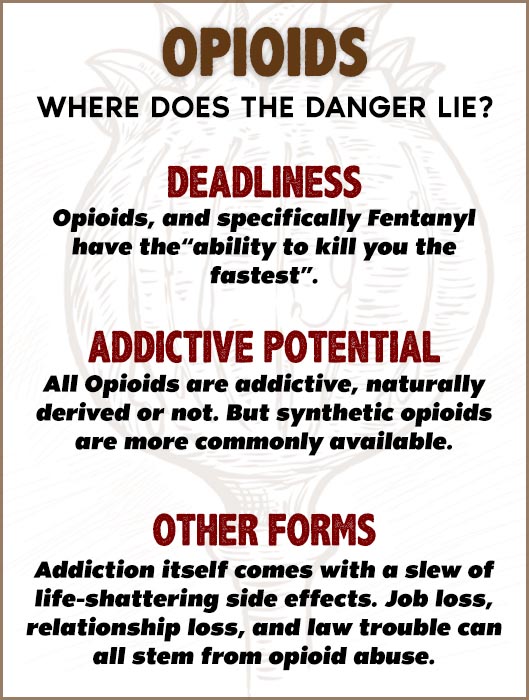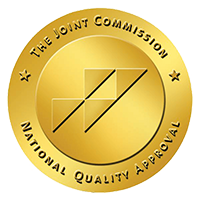Opiates vs Opioids : What’s The Difference?
“Opioid Crisis Costing Massachusetts $2.5 Billion a Year”
“Opioid Crisis is Far From Over in America”
“Opioid Crisis Grips the Heartland”
Headlines across the United States bear witness to the tragedy gripping the American heartland.
The American Opioid Crisis is marching into its third decade, with few signs of slowing. And while cities and states scramble to address the issue, for many, it may be too little, too late.
But the first step in combatting any crisis is knowledge. There is a lot of confusion surrounding the opioid epidemic, some of it with things as basic as the verbiage.
Is it the Opioid crisis? Or the Opiate Crisis? Does it make a difference? Are the two words interchangeable?
They actually aren’t, and though the distinction is subtle, it is vital to understanding the crisis.
So let’s look at the Opioid vs Opiate distinction, and talk about the differences, and which one presents a greater danger.
Opiates vs Opioids: What’s the Difference?
The distinction between opioids and opiates is a matter of set theory. A may equal B, but B does not always equal A.
In this case, Opiates ARE Opioids, but not all Opioids are Opiates.
“Opioid” is a broad term that describes any substance that binds to the opioid receptors in the human brain.
Opioid receptors are part of the opioid system. It’s a part of the nervous system that controls pain, reward, and pleasure. Which means that it figures heavily into addictive behaviors.
Opioids bind to those receptors. They interfere with the brains ability to regulate pleasure and reward, flooding the brain with dopamine.
Opioids come in two types: natural and synthetic. The natural ones, derivatives of the poppy plant, are Opiates. Together with synthetics, they make up the broader category of Opioids.
Opiates: The Original Opioids
Opiates are natural substances, derived from the poppy plant.
They have been in use since at least early Mesopotamia. The people of the area grew poppies, calling them the “Joy Plant” for their ability to induce euphoria. By ancient Greece, doctors were using poppy juice as a narcotic to dull pain.
The ancient world is peppered with the use of opium as everything from a sedative to a cure for psychological disorders. It was a major product for trade and had penetrated Europe by the end of the 16th century.
In 1806, a German chemist was studying opium and managed to isolate a particular substance. He called it “morphine”, and it quickly revolutionized the treatment of pain.
By the American Civil War, doctors were using morphine to sedate patients for surgery. The war was the first sign of opiate addiction in the United States, as hundreds of soldiers came out of the war addicted to morphine.
For the next hundred years, doctors rode the fine line between using morphine and its cousin, codeine, to alleviate pain and avoiding its addictive properties. It was time for a better option.
The Synthetic Opioids Emerge
The supposedly better option arose in the 1920’s, as chemists began developing synthetic opioids. They hoped to maintain the strong pain-fighting abilities while avoiding the addictive properties.
The results were pethidine and methadone, followed by tramadol, propoxyphene, and fentanyl in the 1950s.
Unfortunately, while initially methadone was found to actually treat opioid addiction, it was found almost immediately that these potent painkillers contained the same potential for abuse as their naturally-derived cousins.
Regardless, doctors still continued to prescribe them like candy, avoiding alternative pain relief options in favor of these nearly miraculous pain relief pills.
Where Does the Danger Lie?
Opiates vs Opioids
But the question, of course, is which is MORE dangerous?
At the moment, that question is complicated and depends a lot on how you define danger. Are we talking about danger in sheer ability to kill? Addiction potential? Peripheral danger?
Danger as Deadliness
If you look at danger as “ability to kill you the fastest”, your answer is opioids, and specifically Fentanyl.
Fentanyl is cheaper, stronger, and faster than heroin or other synthetics. So it can be used in smaller, more accessible amounts, and for less expensive. But it can also kill in tiny amounts. A quarter of a milligram is all it takes in some cases.
Fentanyl is so deadly that drugstores are now stocking overdose antidotes over the counter, no prescription required, and some police departments are carrying it as a matter of policy.
Danger as Addictive Potential
All Opioids are addictive, naturally derived or not. But synthetic opioids are more commonly available.
Morphine is not commonly prescribed anymore, and certainly not to take home. Instead, surgical and other pain patients take home Oxycontin or Vicodin.
These take-home prescriptions are where addiction starts, so many could argue that they are the most dangerous, as they are the true gateway drugs to the horrifying world of opioid addiction.
They also have the highest death count. In 2014, 18,000 people died of an opioid overdose, compared to “only” 8,000 from Heroin, an opiate.
Danger in Other Forms
Danger from opioids comes from more than just overdose.
Addiction itself comes with a slew of life-shattering side effects. Job loss, relationship loss, and law trouble can all stem from opioid abuse.
It’s also important to note that many addicts eventually turn to heroin. It’s cheaper and sometimes easier to procure than prescription pills. And, if injected, it also carried extra risks, like HIV and Hepatitis.
It’s All Dangerous
The truth is, there’s no such thing as a “safe” opioid. Whether synthetic or a naturally derived opiate like morphine or heroin, the danger exists regardless. Opiates vs Opioids isn’t really the question we should be asking.
While this shouldn’t discourage anyone who legitimately needs powerful pain relief, such as those who are post-surgery, it is something that should make them wary. Exploring alternative pain relief options, taking pain medication for as short a time as possible, and only when needed…these things are vital.
And as the crisis burns through the United States, the question is less about what is more dangerous and more about what can be done. The problem is complicated and multifaceted.
But for individuals and families suffering, it doesn’t have to be. Rehabilitative help for opioid addicts is available. For more on how we can help you retake your life, contact us today.Most PPO Health









